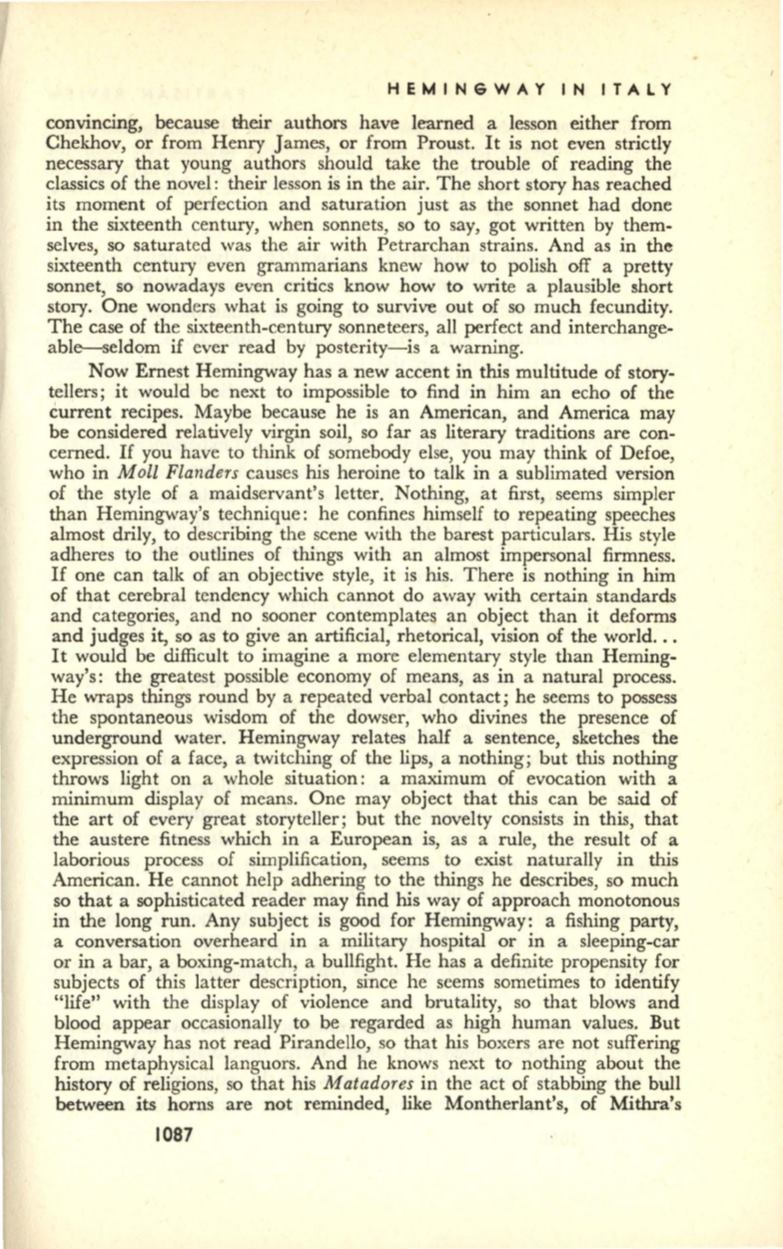
HEMINGWAY IN ITALY
convincing, because their authors have learned a lesson either from
Chekhov, or from Henry James, or from Proust. It is not even strictly
necessary that young authors should take the trouble of reading the
classics of the novel: their lesson is in the air. The short story has reached
its moment of perfection and saturation just as the sonnet had done
in the sixteenth century, when sonnets, so to say, got written by them–
selves, so saturated was the air with Petrarchan strains. And as
in
the
sixteenth century even grammarians knew how to polish off a pretty
sonnet, so nowadays even critics know how to write a plausible short
story. One wonders what is going to survive out of so much fecundity.
The case of the sixteenth-century sonneteers, all perfect and interchange–
able-seldom if ever read by posterity-is a warning.
Now Ernest Hemingway has a new accent in this multitude of story–
tellers; it would
be
next to impossible to find in him an echo of the
current recipes. Maybe because he is an American, and America may
be considered relatively virgin soil, so far as literary traditions are con–
cerned.
If
you have to think of somebody else, you may think of Defoe,
who in
Moll Flanders
causes his heroine to talk in a sublimated version
of the style of a maidservant's letter. Nothing, at first, seems simpler
than Hemingway's technique: he confines himself to repeating speeches
almost drily, to describing the scene with the barest particulars. His style
adheres to the outlines of things with an almost impersonal firmness.
If
one can talk of an objective style, it is his. There is nothing in him
of that cerebral tendency which cannot do away with certain standards
and categories, and no sooner contemplates an object than it deforms
and judges it, so as to give an artificial, rhetorical, vision of the world...
It would be difficult to imagine a
more
elementary style than Heming–
way's: the greatest possible economy of means, as in a natural process.
He wraps things round by a repeated verbal contact; he seems to possess
the spontaneous wisdom of the dowser, who divines the presence of
underground water. Hemingway relates half a sentence, sketches the
expression of a face, a twitching of the lips, a nothing; but this nothing
throws light on a whole situation: a maximum of evocation with a
minimum display of means. One may object that this can be said of
the art of every great storyteller; but
the
novelty consists in this, that
the austere fitness which in a European is, as a rule, the result of a
laborious process of simplification, seems to exist naturally in this
American. He cannot help adhering to the things he describes, so much
so that a sophisticated reader may find his way of approach monotonous
in the long run. Any subject is good for Hemingway: a fishing party,
a conversation overheard in a military hospital or in a sleeping-car
or in a bar, a boxing-match, a bullfight. He has a definite propensity for
subjects of this latter description, since he seems sometimes to identify
"life" with the display of violence and brutality, so that blows and
blood appear occasionally to be regarded as high human values. But
Hemingway has not read Pirandello, so that his boxers are not suffering
from metaphysical languors. And he knows next to nothing about the
history of religions, so that his
Mat adores
in the act of stabbing the bull
between its horns are not reminded, like Montherlant's, of Mithra's
1087


